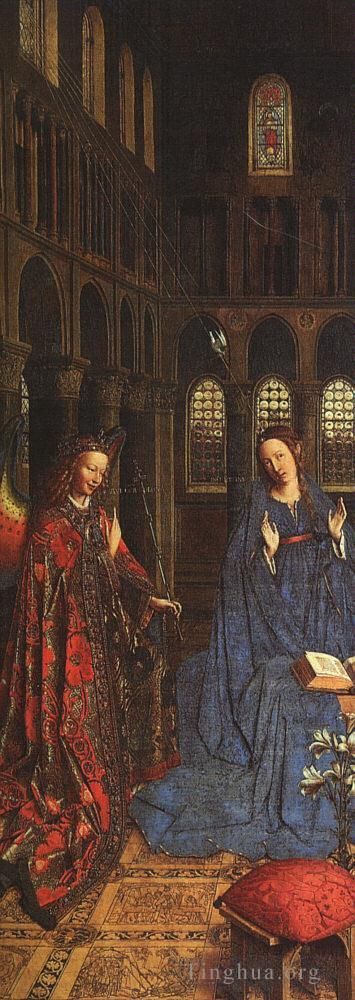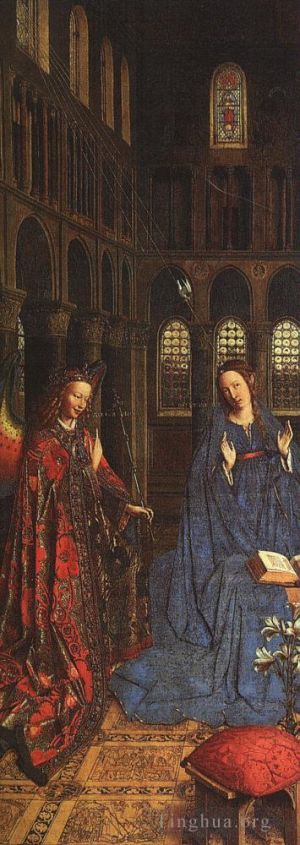The Annunciation 1435
Jan van Eyck
- Price: Price on Request
- Art Type: Oil Painting
- Size:
- English Comments: 0
- International Comments: 0
- Creating Date:
- Introduction and Works of Jan van Eyck >>
Keywords:
Annunciation
Work Overview
- The Annunciation
Jan van Eyck
Oil transferred from wood to canvas
c. 1434
93 x 37 cm
National Gallery of Art, Washington, DC
The Annunciation is an oil painting by the Early Netherlandish master Jan van Eyck, from around 1434-1436. The panel is housed in the National Gallery of Art, in Washington D.C. It was originally on panel but has been transferred to canvas. It is thought that it was the left (inner) wing of a triptych; there has been no sighting of the other wings since before 1817. The annunciation is a highly complex work, whose iconography is still debated by art historians.
The picture depicts the Annunciation by the Archangel Gabriel to the Virgin Mary that she will bear the son of God (Luke 1:26-38). The inscription shows his words: AVE GRÃ. PLENA or "Hail, full of grace...".[1] She modestly draws back and responds, ECCE ANCILLA DÑI or "Behold the handmaiden of the Lord".[2] The words appear upside down because they are directed to God and are therefore inscribed with a God's-eye view. The Seven gifts of the Holy Spirit descend to her on seven rays of light from the upper window to the left, with the dove symbolising the Holy Spirit following the same path; "This is the moment God's plan for salvation is set in motion. Through Christ's human incarnation the old era of the Law is transformed into a new era of Grace".
The setting develops this theme. Mary was believed in the Middle Ages to have been a very studious girl who was engaged by the Temple of Jerusalem with other selected maidens to spin new curtains for the Holy of Holies.[4] The book she is reading here is too large to be a lady's Book of Hours; as in other paintings she is engaged in serious study in a part of the Temple (one medieval authority specified that she was reading the Book of Isaiah when Gabriel arrived).[5] The van Eycks were almost the first to use this setting in panel painting, but it appears earlier in illuminated manuscripts, and in an altarpiece of 1397 from the same monastery for which this painting was probably ordered.[6]
The architecture moves from older, round Romanesque forms above, to (slightly) pointed Gothic arches below, with the higher levels largely in darkness, and the floor level well-lit.[7] The gloom of the Old Covenant is about to be succeeded by the light of the New Covenant. The flat timber roof is in poor repair, with planks out of place.[8] The use of Romanesque architecture to identify Jewish rather than Christian settings is a regular feature of the paintings of van Eyck and his followers, and other paintings show both styles in the same building in a symbolic way.
The decoration of the Temple is naturally all derived from the Old Testament, but the subjects shown are those believed in the Middle Ages to prefigure the coming of Christ the Messiah. In the floor tiles David's slaying of Goliath (centre front), foretells Christ's triumph over the devil. Behind this, Samson pulls down the Temple of the Philistines, prefiguring both the Crucifixion and the Last Judgement, according to medieval authorities. To the left, Delilah is cutting Samson's hair (Betrayal of Christ), and behind he slays the Philistines (Christ's triumph over sin). The death of Absalom and possibly that of Abimelech are identified by some art historians, although only tiny sections are visible. Erwin Panofsky, who developed much of this analysis, proposed a scheme for the significance of the astrological symbols in the round border tiles, and other versions have been suggested.[10]
The rear wall has a single stained glass window, where Jehovah stands, above triple plain-glazed windows below, which perhaps suggest the Christian trinity. On either side of the single window are dim wall-paintings of the Finding of Moses by Pharaoh's daughter (left, pre-figuring the Annunciation itself), and Moses receiving the Ten Commandments (right, paralleling the New Covenant Christ would bring). Below them are roundels with Isaac and Jacob, for which various symbolic functions have been proposed.[11] The lilies are a traditional attribute of Mary, standing for purity. The empty stool may be an "empty throne", a symbol for Christ going back to early Byzantine art.
A cleaning in 1998, and examination by modern technical methods such as infrared reflectograms, has revealed much about van Eyck's technique here, which is consistent with other works of his such as the Arnolfini Portrait. His underdrawing has been revealed, and so have many changes made in the course of painting the work.[21]
Van Eyck's superb oil painting technique is evident throughout. Gold leaf is only used for the seven rays coming in from the left; paint is used for all the gold on Gabriel, often worked wet-on-wet to achieve the textural effects of his brocaded clothes. In a shadowy area behind the stool van Eyck worked a glaze with his fingers.[22] The play of light over the many different textures in the painting is brilliantly rendered, and the illusionistic detail, especially in Gabriel's rich costume, is exceptional.
Apart from several small changes in the position of hands and faces, the under-drawing shows that the small pilasters on the left wall were originally planned to be repeated on the rear wall, and to be much taller, reaching nearly to the roof, on both. The paint on the rear wall is thicker than on the left wall, so he may have painted the pilasters before changing his mind. In the underdrawing the ceiling planks are all in place, and there was also a light source to the right, for which the shadows are drawn.[23]
The narrative scenes on the tiles replace a simpler decorative plan in the underdrawing, and the stool has become much larger. The vase of lilies was not only absent in the underdrawing, but was not reserved, that is to say that a space was not left for it in the paint for the Virgin's robe or the floor. This suggests it was only added late in the course of painting.[24]
Examination of other major van Eyck works reveals similar developments from the underdrawing, and in the course of painting, in these works. It seems van Eyck, perhaps acting with clerical advisers, although he appears to have been a considerable reader himself, liked to add further complexity to his compositions in the course of work on them.
The painting was transferred from panel to canvas in the 19th century. It received a major cleaning in 1998, when varnish and some overpaint was removed, and a technical study undertaken.[26] Writing before this, the NGA catalogue described the painting as extensively restored. Craquelure (fine cracking to the surface) had been painted over, especially in the background. Repainted areas included parts of Gabriel's face and hair, and the Virgin's robe, which appeared to have also lost a layer of glaze.[27]
The range of dates given for the painting was previously from 1428-29 (Panofsky and others) to 1436-37, but the discovery in 1959 of a date of 1437 on an altarpiece in the Gemäldegalerie Alte Meister, Dresden has considerably changed all van Eyck dating, and "makes it all but impossible to continue dating the Annunciation before 1432" (Hand). The painting appears stylistically to come between the Ghent Altarpiece and late works such as the Berlin Virgin in a church.[28]
Two authorities have considered the painting to belong to Jan's brother Hubert van Eyck, who died in 1426. It is thought that the recent cleaning or technical investigation has tended to confirm the majority view that it is an autograph work by Jan.
- Copyright Statement:
All the reproduction of any forms about this work unauthorized by Singing Palette including images, texts and so on will be deemed to be violating the Copyright Laws.
To cite this webpage, please link back here.
- >> English Comments
- >> Chinese Comments
- >> French Comments
- >> German Comments
- >>Report
- The Ghent Altarpiece The Killing of Abel
- The Ghent Altarpiece wings closed
- Small Triptych outer panels
- Annunciation 1
- Annunciation 2
- Madonna with the Child Reading
- Stigmatization of St Francis
- The Ghent Altarpiece Angels Playing Music
- The Ghent Altarpiece The Soldiers of Christ
- St Barbara
- The Virgin of Chancellor Rolin
- The Ghent Altarpiece God Almighty
- Crucifixion
- Portrait of Giovanni Arnolfini
- Portrait of a Young Man Tymotheos
- The Ghent Altarpiece Adoration of the Lamb
- Small Triptych central panel
- The Ghent Altarpiece Prophet Zacharias
- Man in a Turban
- The Ghent Altarpiece Adoration of the Lamb The Holy Hermits
- Portrait of Christ
- The Ghent Altarpiece wings open
- The Ghent Altarpiece Eve
- The Ghent Altarpiece Virgin Mary
- Portrait of Margareta van Eyck
- Portrait of Baudouin de Lannoy
- Suckling Madonna Enth
- Dresden Triptych (Virgin and Child with St Michael and St Catherine and a Donor or Triptych of the Virgin and Child)
- Portrait of a Man with Carnation
- Last Judgment
- The Madonna with Canon van der Paele
- Madonna and Child at the Fountain
- Madonna in the Church
- The Arnolfini Portrait (The Arnolfini Wedding or The Arnolfini Marriage or the Portrait of Giovanni Arnolfini and his Wife)
- The Ghent Altarpiece The Just Judges
- The Ghent Altarpiece St John the Baptist
- Portrait of Cardinal Niccolo Albergati
- The Ghent Altarpiece Singing Angels
- The Ghent Altarpiece Adoration of the Lamb The Holy Pilgrims
- The Ghent Altarpiece The Donor
- The Ghent Altarpiece Angel of the Annunciation
- Portrait of Jan de Leeuw
- Portrait of a Goldsmith Man with Ring
- The Ghent Altarpiece Adam
- The Ghent Altarpiece Erythraean Sibyl
- The Ghent Altarpiece The Donors Wife
- The Ghent Altarpiece Prophet Zacharias Angel of the Annunciation
- The Ghent Altarpiece Mary of the Annunciation
- The Annunciation 1435









 Singing Palette
Singing Palette